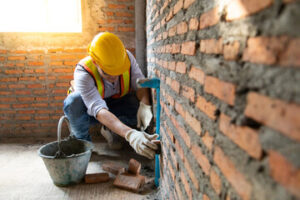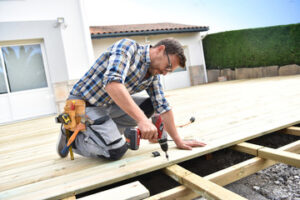Any renovation work that involves brick, stone, or concrete requires the expertise of a masonry contractor. If you encounter cracks in your brick, a professional mason can repair them before they become worse.

Moreover, well-executed masonry enhances the functionality and aesthetic of a renovation, thus increasing its long-term value. Here are the essential skills to look for in a mason. Contact Masonry Contractors Charleston SC for professional help.
Masonry is an ancient art that can add both beauty and value to your home. Whether you want to build a retaining wall, paver patio or stunning fireplace, a skilled mason can help you create the perfect space. However, it is important to choose the right contractor for your project. This will ensure that your renovations are of the highest quality and will stand the test of time.
In addition to their experience, masonry contractors should have adequate tools for the job. They should also be able to use modern technology, such as 3D models and virtual reality, to design and visualize the final product before work begins. This will help to minimize mistakes and save on materials costs.
When it comes to masonry, many different types of materials can be used. These include brick, stone, concrete and cement blocks. A masonry expert should be familiar with all of these, so you can find the best solution for your home.
Having experience in working with these materials allows a mason to offer more solutions to homeowners, which can save them time and money. They will be able to recommend the best material for your project, as well as suggest different designs and colors. In addition, they will be able to answer any questions you may have about the materials.
Masonry experts are also knowledgeable about building codes and regulations, which can protect you from fines or unsafe structures. They will be able to advise you on how to comply with these rules, as well as provide you with any required permits.
A good masonry professional will be honest with you about the cost of your project and the timeline. They should also provide you with a written contract that outlines the scope of work, timeline, and payment terms. A reputable contractor will never charge more than they are worth, but you should be wary of unusually low estimates that may indicate subpar workmanship or materials.
One of the most important qualities of a masonry contractor is clear communication. They will communicate with you regularly, updating you on progress and any issues that arise. This will keep you informed and avoid any surprises down the road.
License
Masonry contractors are responsible for building, repairing, and restoring structures made from brick, stone, concrete blocks, glass block, and other materials. They can work in residential and commercial settings. They may also repair or replace existing walls, partitions, arches, and sewers. They typically need a license to work in the field, though requirements may vary by state and setting. Some states have a separate licensing requirement for residential and commercial settings, while others require the same license for both.
When choosing a masonry contractor, look for one with a strong reputation for customer service and quality work. In addition, it is important to verify that they have a valid license and insurance coverage. This will ensure that they are up to date on the latest safety protocols and adhere to local regulations.
Professional masonry work adds value and beauty to homes. From elegant stone facades to intricate brickwork, these renovation projects enhance both the aesthetic and functionality of a home. They can also make a property more appealing to potential buyers, which can increase its market value.
A reputable masonry contractor will be well-versed in local building codes, ensuring that their work is compliant with regulations and safe for the occupants of the home or business. In addition, they will be able to provide advice and recommendations for the best products and design for the project at hand.
Masonry contractors can build a wide range of structures, including chimneys, fireplaces, and patios. They can also create custom accent walls to add character and dimension to a space. Choosing the right masonry contractor will help you achieve a successful and beautiful renovation project.
Masonry work can be challenging for homeowners to complete on their own. However, with the right tools and equipment, it is possible to build a small retaining wall or create a garden path. Homeowners should also consider hiring a masonry contractor for more complex projects, such as building a fire pit or stone accent wall. This way, they can be confident that their renovation will meet their expectations and add value to the home.
Insurance
Masonry is a labor-intensive and dangerous trade, requiring the use of heavy, potentially dangerous tools and strenuous physical work. Because of this, masonry contractors face numerous inherent risks that can lead to costly damages and liabilities, such as employee injuries, property damage, and business interruption. These risks can be mitigated with a comprehensive insurance package.
Whether they are building or repairing brick walls, brick patios, stone fireplaces, concrete block buildings, or other masonry construction projects, masons require specialized business insurance coverage to protect their businesses. These policies can include commercial general liability, workers’ compensation, and other industry-specific insurance coverage. This insurance can also cover the costs of legal fees and settlements related to claims or lawsuits filed against a mason by clients as a result of professional negligence.
In addition, masonry contractors often use expensive tools and equipment in their day-to-day operations. This equipment can be at risk for theft or loss, especially if it is stored in a shed or transported from one job site to another. Tools and equipment coverage can help offset the cost of replacing these essential tools when they are stolen or lost.
It’s not uncommon for masonry contractors to encounter property damage while working at client sites. For example, if a mason’s employees accidentally drop a large piece of rock that smashes a window, the client may sue the mason for property damage. Commercial general liability can help cover the costs of a lawsuit resulting from accidental damage to a client’s property.
If a worker gets injured on the job, workers’ compensation insurance can pay for their medical bills and lost wages. In addition, it can cover funeral expenses in the event of a fatal accident. This type of insurance is a must-have for any reputable masonry company.
Whether you’re looking for commercial general liability, workers’ comp, or other industry-specific insurance for your masonry contractor company, Western’s licensed business insurance experts are available to help. We’ll review your coverage needs and recommend the right policy to meet your unique business needs. Call us today for a free quote on your masonry business insurance!
Reputation
Masonry is a construction method that uses brick, stone, and concrete blocks to create beautiful, long-lasting structures. It can withstand harsh weather conditions and is known for its durability and classic style. Choosing the right mason contractors can make all the difference in your home improvement projects. Look for contractors with experience, accreditations, and a solid reputation.
Mason contractors construct and repair a variety of structures, including walls, walkways, chimneys, and patios. They also provide concrete services such as laying foundations, pouring concrete, and repairing existing structures. They can also add decorative touches to your property, such as veneer stone and faux stone finishes. Whether you need a new driveway, patio, or retaining wall, hiring the right mason contractors can improve your home’s value and curb appeal.
The cost of masonry work depends on a few factors, including the materials used and labor requirements. High-quality materials are essential for a durable finished product, so they can be expensive. Additionally, masons must carefully place each piece of brick to ensure precision and stability. This requires skilled labor, which adds to the cost of the project.
It is also important to choose a contractor with a strong local reputation. They will be familiar with the unique climate challenges and architectural styles of your area, which helps them to design structures that blend seamlessly into the landscape and stand up to the elements. Local mason contractors are also more likely to be familiar with local building codes and regulations, reducing the risk of costly errors and delays.
Hiring a mason contractor is an investment, so it’s important to choose one with a good reputation. Look for a contractor with a proven track record, accreditations, and a solid customer service reputation. You should also be sure to check their insurance coverage before hiring them for any projects. This will protect you in the event of any accidents or injuries on the job. By taking the time to find a reliable contractor, you can be sure that your masonry project will be completed efficiently and beautifully.


